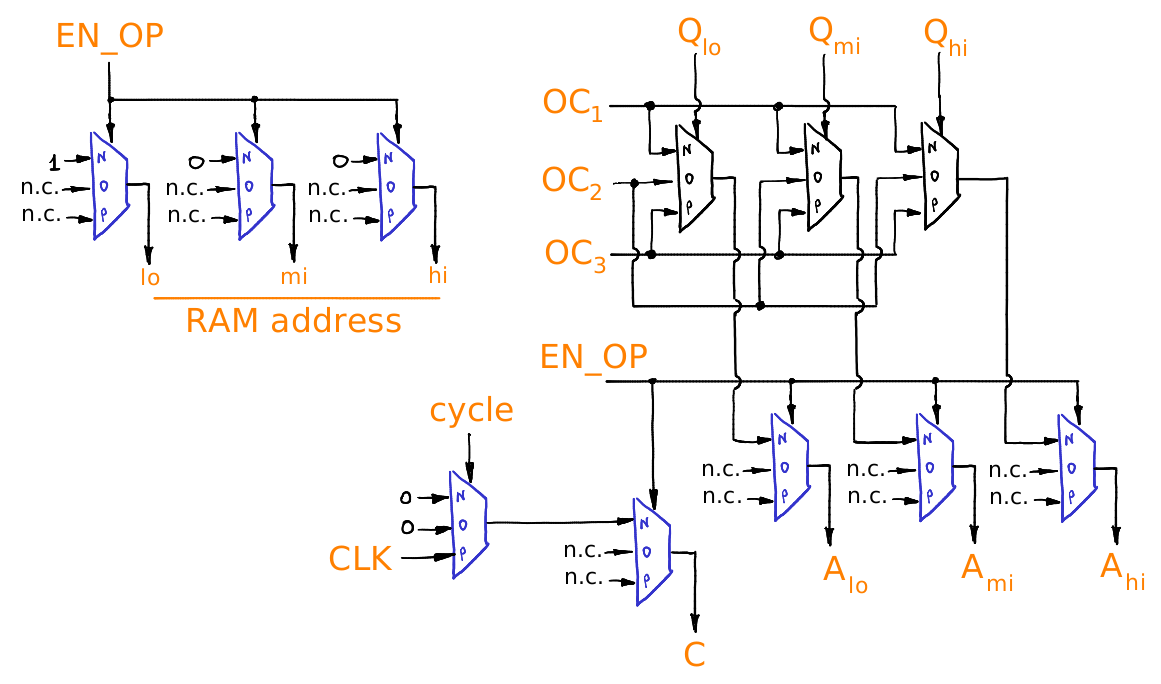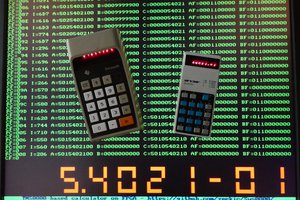In this project we are trying to build a very simple but functional 3-trit balanced ternary computer. The only building block allowed is a ternary multiplexer based on DG403 analog switches.

══════════════════════════════════════════════════════════
Description of the ternary computer TRIADOR
══════════════════════════════════════════════════════════
General purpose
registers
trits 2 1 0 (a trit can take -1,0,+1 values)
┌─┬─┬─┐
R1│ │ │ │ \
├─┼─┼─┤ | Program memory
R2│ │ │ │ | trits 4 3 2 1 0
├─┼─┼─┤ |-- main set ┌─┬─┬─┬─┬─┐
R3│ │ │ │ | of registers a -364│ │ │ │ │ │
├─┼─┼─┤ | d ├─┼─┼─┼─┼─┤
R4│ │ │ │ / d -363│ │ │ │ │ │
├─┼─┼─┤ r ├─┼─┼─┼─┼─┤
R5│ │ │ │ \ e -362│ │ │ │ │ │
├─┼─┼─┤ | s ├─┼─┼─┼─┼─┤
R6│ │ │ │ | s : : : : : :
├─┼─┼─┤ | ├─┼─┼─┼─┼─┤
R7│ │ │ │ | -1 │ │ │ │ │ │
├─┼─┼─┤ | ├─┼─┼─┼─┼─┤
R8│ │ │ │ | 0 │ │ │ │ │ │
├─┼─┼─┤ |-- extra registers ├─┼─┼─┼─┼─┤
R9│ │ │ │ | +1 │ │ │ │ │ │
├─┼─┼─┤ | ├─┼─┼─┼─┼─┤
R10│ │ │ │ | : : : : : :
├─┼─┼─┤ | ├─┼─┼─┼─┼─┤
R11│ │ │ │ | +363│ │ │ │ │ │
├─┼─┼─┤ | ├─┼─┼─┼─┼─┤
R12│ │ │ │ / +364│ │ │ │ │ │
├─┼─┼─┤ └─┴─┴─┴─┴─┘
R13│ │ │ │ Special register,
└─┴─┴─┘ specifies memory segment for JP ttt
┌─┬─┬─┬─┬─┬─┐
PC │ │ │ │ │ │ │ program counter register (-364..+364)
└─┴─┴─┴─┴─┴─┘
┌─┐
C │ │ borrow/carry flag (+1 borrow, -1 carry)
└─┘
Every 3-trit register can take values from -13 to +13:
t2*9 + t1*3 + t0
where t0,t1,t2 - trits (-1,0,+1)
═══════════════════════════════════════════════════════════
TRIADOR instruction set
═══════════════════════════════════════════════════════════
(for lisibility we use N,O,P instead of -1,0,+1)
┌───────┬────────┬───────────────────────────────────────┐
│op code│mnemonic│ description │
├───────┼────────┼───────────────────────────────────────┤
│ NNttt │ EX ttt │ extension commands (work in progress) │
├───────┼────────┼───────────────────────────────────────┤
│ NOttt │ JP ttt │ unconditional jump to R13*27+ttt │
├───────┼────────┼───────────────────────────────────────┤
│ NPttt │ SK ttt │ conditional skips of the next command │
├───────┼────────┼───────────────────────────────────────┤
│ ONttt │ OP ttt │ tritwise unary operation over R1 │
├───────┼────────┼───────────────────────────────────────┤
│ OOttt │ RR ttt │ copying between registers │
├───────┼────────┼───────────────────────────────────────┤
│ OPttt │ R1 ttt │ write ttt to the register R1 │
├───────┼────────┼───────────────────────────────────────┤
│ PNttt │ R2 ttt │ write ttt to the register R2 │
├───────┼────────┼───────────────────────────────────────┤
│ POttt │ R3 ttt │ write ttt to the register R3 │
├───────┼────────┼───────────────────────────────────────┤
│ PPttt │ R4 ttt │ write ttt to the register R4 │
└───────┴────────┴───────────────────────────────────────┘
Additional comments:
- ttt means a 3-trit number with values
from NNN (-13) to PPP (+13)
- RR ttt instruction copies a register to/from R1 or performs
an increment/decrement over R1
OONNN — copy R1 to R13
OONNO — copy R1 to R12
OONNP — copy R1 to R11
OONON — copy R1 to R10
OONOO — copy R1 to R9
OONOP...
Read more »
 Dmitry V. Sokolov
Dmitry V. Sokolov



 So we need to have ONE DG403 per every binary represented TRIT and it doesn't matter if it's input or output, but number of inputs should be multiple by 2 in order to use DG403 chips optimally.
So we need to have ONE DG403 per every binary represented TRIT and it doesn't matter if it's input or output, but number of inputs should be multiple by 2 in order to use DG403 chips optimally.






 Artem Kashkanov
Artem Kashkanov
 spudfishScott
spudfishScott
 Pavel
Pavel
 zpekic
zpekic
Hello. Your project seems interesting but dg403 is so expensive and is not easy to find.
I don't know much about Electronics but perhaps they can be replaced with 4016? 300 of them have enough analogue switches and the price will be reduced a LOT.